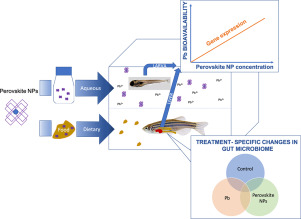当前位置:
X-MOL 学术
›
Sci. Total Environ.
›
论文详情
Our official English website, www.x-mol.net, welcomes your feedback! (Note: you will need to create a separate account there.)
Exposure to Pb-halide perovskite nanoparticles can deliver bioavailable Pb but does not alter endogenous gut microbiota in zebrafish.
Science of the Total Environment ( IF 9.8 ) Pub Date : 2020-01-25 , DOI: 10.1016/j.scitotenv.2020.136941 Danae Patsiou 1 , Cristina Del Rio-Cubilledo 2 , Ana Isabel Catarino 3 , Stephen Summers 4 , Afiq Mohd Fahmi 5 , David Boyle 6 , Teresa F Fernandes 2 , Theodore B Henry 7
Science of the Total Environment ( IF 9.8 ) Pub Date : 2020-01-25 , DOI: 10.1016/j.scitotenv.2020.136941 Danae Patsiou 1 , Cristina Del Rio-Cubilledo 2 , Ana Isabel Catarino 3 , Stephen Summers 4 , Afiq Mohd Fahmi 5 , David Boyle 6 , Teresa F Fernandes 2 , Theodore B Henry 7
Affiliation

|
Lead-halide perovskite nanoparticles (NPs) are a new technology, and investigation of toxicity is of considerable importance due to the potential lead (Pb) release into the environment. The aim of the study was to investigate aqueous and dietary toxicity of Pb-halide perovskite NP and Pb in zebrafish Danio rerio. Perovskite NP toxicity was evaluated in zebrafish by mortality, gene expression, histopathology, and phylogenetic analysis of gut microbiota. Zebrafish larvae were exposed to five Pb-halide perovskite NPs in parallel with Pb(NO3)2 exposures, and zebrafish adults were exposed to the three perovskite NPs that caused the strongest effect and Pb(NO3)2. No median lethal concentration (LC50) was observed for zebrafish larvae exposed to up to 200 mg/L of perovskite NPs for 96 h. Mortality, metallothionein 2 (mt2) and δ-aminolevulinic acid dehydratase (ala-d) gene expression (24-h exposure) in zebrafish larvae after aqueous perovskite NPs exposures did not differ from total Pb concentration - response curves. The lack of differences in mortality and gene expression between perovskite NPs and soluble Pb after aqueous exposure suggest that toxicity from perovskite NPs can be attributed to bioavailable Pb rather than nano-specific effects. Induction of mt2 and reduction of ala-d expression levels in liver tissues showed Pb bioavailability after 2-d and 4-d dietary exposure to perovskite-spiked feeds. Changes in gut microbiota of adult zebrafish were detected after 14-d exposure to Pb-spiked food, but no changes were detected from perovskite-NP spiked food. The phylogenetic analysis identified different microbiome profiles of Pb-fed fish compared to perovskite-fed fish suggesting a different mechanism of toxicity. Exposure to Pb-halide perovskite NPs led to absorption of Pb likely from release of Pb ions rather than absorption of NPs. Pb-halide perovskite NPs can release bioavailable Pb and this needs to be considered during the development of this technology.
中文翻译:

铅-卤化物钙钛矿纳米颗粒的暴露可以提供生物利用性铅,但不会改变斑马鱼中的内源性肠道菌群。
卤化钙钛矿铅纳米颗粒(NPs)是一项新技术,由于潜在的铅(Pb)释放到环境中,因此毒性研究非常重要。这项研究的目的是研究斑马鱼Danio rerio中的Pb-卤化物钙钛矿NP和Pb的水和食物毒性。通过死亡率,基因表达,组织病理学和肠道菌群的系统发育分析评估了斑马鱼中钙钛矿NP的毒性。斑马鱼幼虫与五个Pb-卤化物钙钛矿NPs平行暴露于Pb(NO3)2暴露,斑马鱼成虫暴露于三个钙钛矿NPs引起最强的作用和Pb(NO3)2。暴露于高达200 mg / L钙钛矿NPs的斑马鱼幼虫在96小时内未观察到中值致死浓度(LC50)。死亡,钙钛矿水溶液NPs暴露后斑马鱼幼虫中金属硫蛋白2(mt2)和δ-氨基乙酰丙酸脱水酶(ala-d)基因表达(暴露24h)与总Pb浓度-响应曲线无差异。在水接触后钙钛矿纳米颗粒和可溶性Pb的死亡率和基因表达缺乏差异,这表明钙钛矿NPs的毒性可归因于生物可利用的Pb,而不是纳米特异性作用。肝组织中mt2的诱导和ala-d表达水平的降低显示了在饮食中钙钛矿加料的2-d和4-d暴露后Pb的生物利用度。成年斑马鱼肠道微生物群的变化在暴露于Pb掺入食物14天后被检测到,但钙钛矿-NP掺入食物未检测到变化。系统发育分析确定了与以钙钛矿喂养的鱼类相比,以铅喂养的鱼类具有不同的微生物组特征,表明其毒性机制不同。暴露于卤化钙钛矿型NPs可能导致Pb离子的吸收而不是NPs的吸收。铅卤化物钙钛矿纳米粒子可以释放生物利用性铅,在开发该技术时需要考虑这一点。
更新日期:2020-01-26
中文翻译:

铅-卤化物钙钛矿纳米颗粒的暴露可以提供生物利用性铅,但不会改变斑马鱼中的内源性肠道菌群。
卤化钙钛矿铅纳米颗粒(NPs)是一项新技术,由于潜在的铅(Pb)释放到环境中,因此毒性研究非常重要。这项研究的目的是研究斑马鱼Danio rerio中的Pb-卤化物钙钛矿NP和Pb的水和食物毒性。通过死亡率,基因表达,组织病理学和肠道菌群的系统发育分析评估了斑马鱼中钙钛矿NP的毒性。斑马鱼幼虫与五个Pb-卤化物钙钛矿NPs平行暴露于Pb(NO3)2暴露,斑马鱼成虫暴露于三个钙钛矿NPs引起最强的作用和Pb(NO3)2。暴露于高达200 mg / L钙钛矿NPs的斑马鱼幼虫在96小时内未观察到中值致死浓度(LC50)。死亡,钙钛矿水溶液NPs暴露后斑马鱼幼虫中金属硫蛋白2(mt2)和δ-氨基乙酰丙酸脱水酶(ala-d)基因表达(暴露24h)与总Pb浓度-响应曲线无差异。在水接触后钙钛矿纳米颗粒和可溶性Pb的死亡率和基因表达缺乏差异,这表明钙钛矿NPs的毒性可归因于生物可利用的Pb,而不是纳米特异性作用。肝组织中mt2的诱导和ala-d表达水平的降低显示了在饮食中钙钛矿加料的2-d和4-d暴露后Pb的生物利用度。成年斑马鱼肠道微生物群的变化在暴露于Pb掺入食物14天后被检测到,但钙钛矿-NP掺入食物未检测到变化。系统发育分析确定了与以钙钛矿喂养的鱼类相比,以铅喂养的鱼类具有不同的微生物组特征,表明其毒性机制不同。暴露于卤化钙钛矿型NPs可能导致Pb离子的吸收而不是NPs的吸收。铅卤化物钙钛矿纳米粒子可以释放生物利用性铅,在开发该技术时需要考虑这一点。


























 京公网安备 11010802027423号
京公网安备 11010802027423号